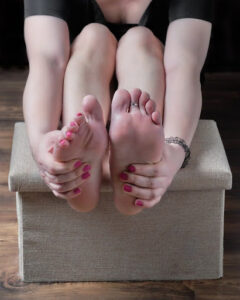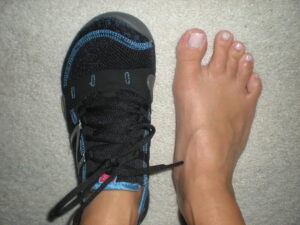Are you experiencing an abrupt and uncomfortable cramping and curling of your toes? If so, you’re not alone. Surprisingly, many people face similar discomfort, usually at the most inconvenient times. Learning how to stop your toes from cramping is essential for alleviating this pain and improving your daily life
Understanding Toe Cramps and Toe Curling
Toe cramps happen suddenly, making your toes curl or twist painfully. They grip your foot muscle tissues tightly and can be pretty stressful.
Imagine you are walking, running, or simply about to sleep when your toes abruptly seize up.
This jarring experience is not just uncomfortable but can be quite worrisome.
Dystonia is an involuntary movement of muscle and can lead to toe-curling making simple tasks challenging. Your toes may clench due to dystonia, leading to discomfort and difficulty in movement.
It is key to know that these are signs your body needs attention. This may mean better shoes, more nutrients, or a visit to the doctor or podiatrist for a check-up. Addressing the pain quickly helps prevent further issues and keeps you moving comfortably throughout your day.
Exploring Common Triggers of Toe Cramps
Understanding the causes of toe cramps is essential in mitigating their occurrence. The involuntary contractions associated with toe cramps can arise from a variety of factors, ranging from lifestyle choices to underlying medical issues.
Dehydration and Mineral Deficiencies: Causes of Toe Cramps
Your toes might cramp and curl if your body lacks water or essential minerals. Drink plenty of fluids to stay hydrated, as dehydration is a common cause of muscle cramps. Minerals like potassium, calcium, and magnesium help your muscles work well.
Make sure you get enough of these in your diet to prevent toe cramps.
If you exercise a lot or it’s hot outside, you may sweat out a lot of minerals. To fix this, eat foods rich in potassium such as bananas and potatoes. Dairy products are good for calcium, and nuts can give you magnesium.
Keeping the right balance of electrolytes will help stop those painful cramps in your toes from happening. Next up: learn about how overusing muscles can also lead to trouble with toe cramps.
Overuse of Muscles
Overusing muscles can lead to a charley horse cramp in your foot. This often happens when you push yourself too hard during sports or exercise. The toe muscles get tired and may start to spasm, causing pain and curling.
To prevent overuse, give your feet time to rest between activities that strain them.
It is important to listen to your body’s signals. If toes begin cramping up, ease off the activity causing it. Regular breaks help maintain muscle health and balance electrolytes critical for muscle function.
Maintain a routine where strenuous exercise is followed by adequate relaxation for muscle recovery.
Inadequate Exercise
Not moving enough can make your toes cramp up. Your muscles need to move to get blood and oxygen. If they don’t, they might start hurting or curling. Strong muscles come from regular exercise.
It keeps them flexible and healthy so you won’t get toe cramps as often.
If you sit a lot and don’t walk or stretch, your muscles may get weak and tight.
This makes it more likely for your toes to cramp. Aim to keep active with exercises that are good for your feet, and you will help stop those painful toe curls.
Now, let’s talk about poorly fitting shoes and how they affect your toes.
Poorly Fitting Shoes: Influence on Toe Cramps
Image Source: Pexels
Shoes that don’t fit right can squeeze your toes too much. This puts extra stress on them and cuts down on blood flow. When shoes are too tight, they squish your feet and stop the blood from moving freely.
This can make your toes cramp up in pain.
High heels and pointed shoes push your toes into a small space. This pressure can make toe cramps worse or even cause clawed toes over time. Choose shoes with enough room to move your toes to help stop cramps.
If you have toe cramps often, it might be due to medical issues like dystonia.
Unpacking Medical Conditions Contributing to Toe Discomfort
Dystonia is a movement disorder that leads to involuntary muscle contractions. These contractions result in twisting, repetitive movements or abnormal postures. For some people, dystonia makes their toes curl or cramp up painfully.
This condition can be quite distressing and interfere with everyday activities.
Symptoms often start in just one area, such as the foot and may include cramps similar to charley horses. In adults who develop focal dystonia of the foot, toe cramping might be a primary symptom.
Tracking these symptoms is crucial because they help doctors diagnose and treat this complex medical condition effectively.
Effective Home Remedies to Alleviate Toe Cramping
You can address toe cramps effectively with simple strategies right from your home, empowering you to manage discomfort and maintain healthy foot function. Embrace these remedies as a proactive approach to reduce the frequency and intensity of muscle contractions that lead to cramping.
1. Hydration and Nutrition: Essential Remedies for Toe Discomfort
Toes often cramp and curl up painfully. This condition can be managed with good hydration and nutrition.
- Drink plenty of water throughout the day to stay hydrated. Your body needs water to keep muscles like those in your toes working well.
- Monitor your intake of calcium, potassium, and magnesium. These minerals help prevent toe cramps.
- Eating bananas, leafy greens, and nuts gives you nutrients that are good for your muscles.
- Cut down on drinks that can dehydrate you such as coffee and alcohol.
- If you sweat a lot or exercise regularly, consider drinking a sports drink to replace lost electrolytes.
- Talk with a doctor about supplementing if you’re not getting enough minerals from food. They can guide you on safe amounts.
2. Proper Footwear Selection: Tips for Toe Cramp Prevention
Choosing the right shoes is crucial for stopping your toes from cramping and curling. Well-fitted footwear can prevent pain and offer support where you need it most.
- Find shoes that fit correctly, with enough room to wiggle your toes comfortably.
- Look for shoes that match your foot shape; this means the widest part of the shoe should align with the ball of your foot.
- Check for good arch support in the shoe to help distribute weight evenly across your feet.
- Choose footwear with a cushioned sole to absorb impact and reduce stress on your toes.
- Ensure shoes are appropriate for your activities – runners need different support compared to casual walking shoes.
- Replace worn – out shoes regularly as old, flattened cushioning won’t protect your feet properly.
- Visit a podiatrist if you have persistent toe cramps; they can suggest custom orthotics designed specifically for your feet.
- Remember that high heels can cause toe cramps and try to limit their use or opt for lower heel options.
3. Regular Exercise and Stretching: Promoting Toe Muscle Flexibility

Image Source: Pexels
Regular exercise and stretching are key to stopping toe cramps. They keep your muscles strong and flexible.
- Start with toe stretches to warm up your feet. Lift and spread your toes, hold for a few seconds, then relax them.
- Exercise your toes by picking up small objects or scrunching a towel with them. This strengthens the smaller muscles in your feet.
- Rotate your ankles in both directions to help improve flexibility. Doing this can prevent stiffness that leads to cramps.
- Stretch your calves daily. Tight calf muscles can pull on the muscles in the foot, causing cramps.
- Walk regularly to keep blood flowing to the feet. Good circulation helps reduce the risk of muscle cramping.
- Practice yoga or Pilates. These activities enhance overall flexibility, which can decrease occurrences of cramps.
- Use resistance bands for foot exercises. Pressing against the bands works on various muscle groups within the foot.
- After extended periods of sitting, stretch and move around. This action avoids cramps from sitting too long.
- Implement balance exercises such as standing on one leg. Balancing activities strengthen foot muscles and offer better control.
Knowing When to Seek Professional Help for Persistent Toe Issues
If you often get toe cramps that feel like a charley horse or if your toes seem to keep curling up, it’s time to check with a podiatrist. Long-lasting pain, persistent cramping, or extreme curling of the toes can also point to something serious.
Look out for signs and symptoms like swelling, redness, or modifications in skin color. These ought to mean there is more going on than simple spasms.
A podiatrist can discern out what is causing these troubles and offer the right treatment. If stretches and higher shoes do not work, you may want medication or different treatments.
Also consult your podiatrist if your toe problems make walking painful or if they mess with daily life. This way, you can handle any more serious issues before they get worse.
Summarizing Strategies for Toe Cramp Relief
Tight shoes and lack of water cause toe cramps. Remember to stretch and wear shoes that fit comfortably. Drink plenty of water, especially when active. Warm soaks and ice packs can ease ache fast. Walk around or jiggle your leg if a cramp starts. See a podiatrist if the trouble keeps happening
FAQs on Toe Cramps: Common Queries Addressed
1. What causes my toes to cramp and curl?
A charley horse cramp in the foot can be a reason that your toes cramp and curl. This may also manifest due to strained muscles, dehydration or lack of certain minerals.
2. Can workout help prevent toe cramps?
Yes, mild stretching and strengthening workouts can enhance muscle fitness and minimse the danger of toe cramps.
3. Should I see a physician for conventional toe cramping?
If you regularly have toe cramps that hurt or don’t go away, it is recommended to speak to a health practitioner to determine why this is happening.
4. Are there any quick remedies when my toes start cramping?
When your toes start to cramp, you can help alleviate the pain by massaging the area gently or taking walks on your heels for relief.






